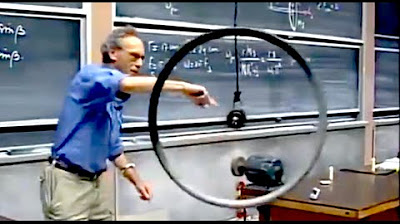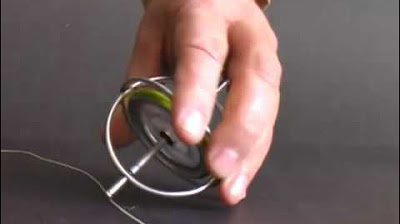How a Gyroscope Works ⚡ What a Gyroscope Is
TLDRThis video script delves into the world of gyroscopes, explaining their dual functionality in measuring orientation and angular velocity. It covers various types of gyroscopes, including mechanical, vibratory, and optical, and their applications in technology and our bodies. The script also discusses the principles of torque, angular momentum, and the Coriolis effect, as well as the Sagnac effect for optical gyroscopes, highlighting their importance in fields like aeronautics, robotics, and everyday devices like smartphones.
Takeaways
- 🌐 Gyroscopes serve two main functions: measuring orientation variation and angular velocity in rotating systems.
- 🔄 They are used in various applications such as smartphones, aeronautics, video game consoles, and robotics.
- 💃 The human body has an innate gyroscope, the vestibular system, which helps with balance and orientation.
- 🔧 Mechanical gyroscopes operate on principles of torque, angular momentum, and Newton's laws.
- 🎢 Foucault's pendulum is an early example of a mechanical gyroscope, demonstrating spatial rigidity of rotation.
- 🏍 Precession is a phenomenon where a rotating object resists change in orientation when subjected to an external force.
- ⚖️ Coriolis effect vibrating gyroscopes measure angular velocity by detecting the Coriolis force on an oscillating mass.
- 📱 These gyroscopes are widely used in small electronic devices due to their compact size and low cost.
- 🌀 Optical gyroscopes utilize the Sagnac effect to detect angular velocity without moving parts, offering high accuracy and reliability.
- 🔬 The Sagnac effect involves two beams of light traveling in opposite directions within an optical ring, with their interference pattern revealing the system's rotation.
- 🏅 Optical gyroscopes are capable of high precision and can now be made very small, as demonstrated by Caltech's 2mm square gyroscope.
Q & A
What is the primary function of a gyroscope?
-A gyroscope primarily functions to provide information about the variation of a system's orientation with respect to a reference axis or to measure the rate at which the orientation of a system varies when it is rotating, which is its angular velocity.
In which applications are gyroscopes commonly used?
-Gyroscopes are used in a wide range of applications including smartphones, aeronautics, video game consoles, robotics, and even in our body's vestibular system which helps maintain balance.
What are the two factors that determine a system's angular momentum?
-The angular momentum of a system is determined by its moment of inertia, which depends on its shape and mass distribution, and the angular velocity, which indicates how many degrees the system rotates during a defined period of time.
How does Newton's first law relate to the operation of a gyroscope?
-Newton's first law states that an object will remain at rest or in uniform motion in a straight line unless acted upon by an external force. In the context of a gyroscope, this principle explains how and why a spinning gyroscope resists changes to its orientation due to the angular momentum of the spinning wheel.
Outlines
🌐 Introduction to Gyroscopes and Their Applications
This paragraph introduces gyroscopes as devices that measure orientation and angular velocity. It explains their widespread use in various applications, such as smartphones, aeronautics, video games, and robotics. The paragraph also mentions the human body's built-in gyroscope, the vestibular system, which helps maintain balance. The video aims to explain how different types of gyroscopes work, including mechanical, Coriolis effect vibratory, and optical gyroscopes, starting with the mechanical gyroscope and its operation based on torque and angular momentum principles.
🔄 Understanding Mechanical Gyroscopes and Precession
This paragraph delves into the mechanics of mechanical gyroscopes, focusing on the concepts of torque and angular momentum. It describes how a rotating system's angular momentum is conserved in the absence of external torque and how Newton's laws apply to rotating systems. The paragraph then discusses two practical applications of mechanical gyroscopes: one that maintains orientation, exemplified by Foucault's pendulum, and another that uses the phenomenon of precession to determine angular velocity. It explains how precession allows a rotating object to change its orientation in response to an applied torque, which is crucial for calculating the system's angular velocity.
📏 Coriolis Effect Vibratory Gyroscopes and Their Integration
This paragraph introduces Coriolis effect vibrating gyroscopes, which are widely used due to their small size and low cost, making them suitable for integration into electronic devices like smartphones. It explains the principle of operation based on Coriolis acceleration, which occurs when a particle in motion experiences a change in its trajectory due to radial movement within a rotating system. The paragraph describes how the Coriolis force affects an oscillating mass, allowing the calculation of angular velocity. However, it also notes the limitation of these gyroscopes when subjected to large linear accelerations, which can compromise their accuracy.
🌟 Optical Gyroscopes and the Sagnac Effect
The final paragraph discusses optical gyroscopes, which detect angular velocities independently of linear accelerations. It explains the Sagnac effect, where two beams of light traveling in opposite directions within a fiber optic ring exhibit different travel times due to the system's rotation. The interference of these beams and the resulting phase difference allow for the calculation of angular velocity. Optical gyroscopes are highlighted for their high accuracy and reliability, as they operate without moving parts. The paragraph also mentions advancements in缩小尺寸, with an example of a tiny optical gyroscope developed in 2018, emphasizing the ongoing development and miniaturization of this technology.
Mindmap
Keywords
💡Gyroscope
💡Angular Momentum
💡Torque
💡Precession
💡Coriolis Effect
💡Optical Gyroscope
💡Vestibular System
💡Moment of Inertia
💡Newton's Laws
💡Sagnac Effect
Highlights
A gyroscope can provide information about orientation variation or angular velocity.
Gyroscopes are used in various applications including smartphones, aeronautics, video game consoles, and robotics.
The human body has a built-in gyroscope called the vestibular system that helps maintain balance.
Mechanical gyroscopes rely on understanding torque and angular momentum.
Newton's laws are fundamental in understanding the operation of mechanical gyroscopes.
Foucault's pendulum used the principle of a rotating disk with conserved angular momentum for orientation.
The second application of mechanical gyroscopes involves determining system speed through precession.
Precession is a circular motion generated when a rotating object is subjected to a force causing orientation change.
Coriolis effect vibrating gyroscopes are widely used due to their small size and low cost.
Coriolis acceleration is key to the operation of vibrating gyroscopes.
Optical gyroscopes detect angular velocities independently of linear accelerations.
The Sagnac effect is the basis for the operation of optical gyroscopes.
Optical gyroscopes are highly accurate and can operate without moving parts.
In 2018, Caltech scientists created an optical gyroscope only two millimeters square.
The gyroscope's moment of inertia affects its accuracy and rotation time.
Friction and torque transmission limit the long-term accuracy of mechanical gyroscopes.
Gravity Probe B uses gyroscopes to test Einstein's theory of relativity.
The design of mechanical gyroscopes is impressive despite their complexity.
Transcripts
Browse More Related Video

8.01x - Lect 24 - Rolling Motion, Gyroscopes, VERY NON-INTUITIVE

Gyroscopic Precession is Easier Than You Think!

Gyroscope

Lec 33: Topological considerations; Maxwell's equations | MIT 18.02 Multivariable Calculus, Fall 07

Classical Mechanics | Lecture 9

AP Physics 1 review of Torque and Angular momentum | Physics | Khan Academy
5.0 / 5 (0 votes)
Thanks for rating: